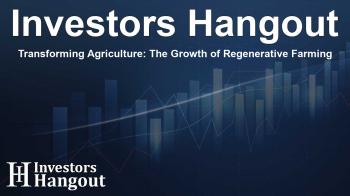Transforming Agriculture: The Growth of Regenerative Farming

Understanding the Regenerative Agriculture Market
The regenerative agriculture market is gaining momentum globally, anticipated to grow from USD 12.95 billion in 2024 to an impressive USD 72.21 billion by 2034. This represents a remarkable compounded annual growth rate (CAGR) of 18.75% during the upcoming decade. The surge in consumer demand for sustainable and organic food is a pivotal factor driving this growth.
The Essence of Regenerative Agriculture
Regenerative agriculture is more than just a farming technique; it embodies a holistic approach to food production that focuses on restoring soil health, boosting biodiversity, and enhancing ecosystem resilience. In contrast to conventional farming methods, which often rely heavily on synthetic chemicals and monocultures, regenerative practices advocate for soil regeneration. Techniques such as crop rotation, cover cropping, reduced tillage, and livestock integration are central to this model. As consumers become increasingly aware of environmentally friendly practices, businesses and governments are also stepping up their efforts to promote regenerative methods through incentives and partnerships.
Key Goals of Regenerative Agriculture
The main objectives of regenerative agriculture encompass:
- Producing sufficient nutritious food to sustain a growing global population.
- Mitigating climate change by sequestering carbon in the soil and lowering greenhouse gas emissions.
- Restoring biodiversity and enhancing natural habitats.
- Preventing deforestation and grassland conversion by improving productivity on existing farmland.
- Improving farmers' livelihoods and long-term viability.
Market Dynamics and Trends
The growth trajectory of the regenerative agriculture market is robust, bolstered by several factors:
- The North American market alone was valued at approximately USD 3.89 billion in 2024 and is projected to reach USD 21.71 billion by 2034.
- North America held approximately 30% of the market share in 2024, indicating its dominance in the sector.
- Soil management practices were reported to have a significant 35% industry share in 2024, highlighting a primary focus on improving soil health.
- Technological advancements are paving the way for optimized farming practices, with data analytics playing a crucial role in decision-making processes.
Benefits of Transitioning to Regenerative Practices
Regenerative agriculture is acknowledged for its myriad benefits that contribute not only to ecological sustainability but also to agricultural productivity:
- Climate Mitigation: Significantly reduces greenhouse gas emissions and promotes carbon capture in the soil.
- Soil Health Restoration: Helps restore soil fertility, stability, and productivity, making it resilient over time.
- Biodiversity Enhancement: Encourages biodiversity recovery, strengthening ecosystems against pests and diseases.
- Resource Efficiency: Ensures optimized use of water and land resources, minimizing wastage.
- Economic Viability: Enhances farm efficiency and reduces reliance on synthetic agricultural inputs, resulting in cost savings.
Challenges and Strategic Implementation
While the benefits are compelling, implementing regenerative agriculture poses various challenges:
- High initial costs related to transitioning from conventional to regenerative methods can deter farmers.
- Lack of standardized practices and verification metrics introduces uncertainty and complicates the transition process.
The successful implementation of regenerative practices demands a strategic approach tailored to local conditions and market needs. Stakeholders must address key questions regarding where and how to implement regenerative strategies, financial considerations, and the role of technology in enhancing farm productivity.
Global Opportunities and Regional Trends
A global shift towards regenerative agriculture is reflected in rising adoption rates across regions:
- North America: Home to many innovative practices driven by policies and consumer demand.
- Asia Pacific: Expected to grow rapidly, driven by increasing awareness of sustainability among consumers.
- Europe: Supported by extensive research and cooperative initiatives promoting education on regenerative practices.
- Latin America: Countries are accelerating the adoption of sustainable farming practices to address environmental challenges.
Frequently Asked Questions
What is the anticipated growth of the regenerative agriculture market?
The market size is expected to grow from USD 12.95 billion in 2024 to USD 72.21 billion by 2034, reflecting a CAGR of 18.75%.
What are the core principles of regenerative agriculture?
The core principles include minimizing soil disturbance, maximizing crop diversity, maintaining living roots in the soil, and integrating livestock into the farming system.
How does regenerative agriculture contribute to climate action?
It mitigates greenhouse gas emissions through practices that enhance soil carbon storage and reduces net emissions from agricultural activities.
What are the significant market challenges?
Key challenges include high upfront investments, lack of standardization in practices, and insufficient verification systems which can hinder adoption.
Why is technology important in regenerative agriculture?
Technology plays a crucial role in monitoring soil health, optimizing farm practices, and facilitating data-driven decision making, which enhance the efficiency of regenerative methods.
About The Author
Contact Thomas Cooper privately here. Or send an email with ATTN: Thomas Cooper as the subject to contact@investorshangout.com.
About Investors Hangout
Investors Hangout is a leading online stock forum for financial discussion and learning, offering a wide range of free tools and resources. It draws in traders of all levels, who exchange market knowledge, investigate trading tactics, and keep an eye on industry developments in real time. Featuring financial articles, stock message boards, quotes, charts, company profiles, and live news updates. Through cooperative learning and a wealth of informational resources, it helps users from novices creating their first portfolios to experts honing their techniques. Join Investors Hangout today: https://investorshangout.com/
The content of this article is based on factual, publicly available information and does not represent legal, financial, or investment advice. Investors Hangout does not offer financial advice, and the author is not a licensed financial advisor. Consult a qualified advisor before making any financial or investment decisions based on this article. This article should not be considered advice to purchase, sell, or hold any securities or other investments. If any of the material provided here is inaccurate, please contact us for corrections.

